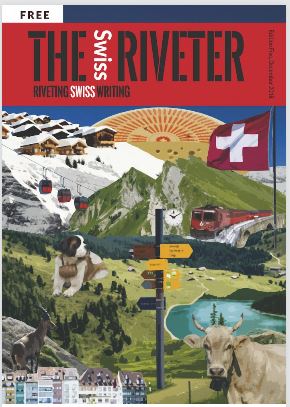Before getting to the ‘how to’, a word about why you might want to review fiction! Here are some reasons:
- to spread the word about books you love – it can be a way of saying ‘thank you’ to the author for a great read
- to hone your creative writing skills: a thorough analysis of others’ work improves our own
- for some experience of the world of publishing and book publicity
- to engage with communities of fellow literature lovers
- to establish your competence in a genre or area
- to promote the value of the arts (e.g., for their role in educating empathy, openness and cross-cultural understanding).
For me, the last of these points is really important. I’ve therefore reviewed a great deal of literature in translation for The European Literature Network, opera for Seen and Heard International and arts & culture topics for Talking Humanities and others.
So, what to consider when reviewing a work of fiction? Here are my top ten tips.
- Begin with a gripping line or paragraph which conveys your overall opinion. It could be phrased as (a) a statement or (b) a question. As an alternative, you could begin with (c) a quote from the book which encapsulates its themes. An example of each:
- The title says it all: smoking kills – though in the case of this novel, the victim is not the smoker but those he kills (‘and not through passive smoking,’ he clarifies) in order to enjoy the pleasures of a cigarette. We’re firmly in humour noir territory: the book’s incisive, satirical take on modern-day life offers a succession of laugh-out-loud moments.[1]
- What might drive a left-wing intellectual to espouse xenophobic views and defend the indefensible? How might the community around him react? How would you react if he were your father? In Autopsy of a Father, Pascale Kramer poses uncomfortable questions and tests your tolerance of disquiet.[2]
- ‘“Fate,” said Arthur. “The capital letter F. But chance is a powerful force, and suddenly you acquire a Fate that was never assigned to you. Some kind of accidental fate. It happens in a flash.”’[3]
- Give us a reason why we should read the book / why it should spark our curiosity
- E.g.: One of the most original novels I’ve read in a long time, The Core of the Sun is set in an alternative present – in the “Eusistocratic Republic of Finland”.[4]
- In your plot summary, tell us about the protagonist(s)’ approach to the key issue/conflict/mystery
- E.g.: Caterina’s process of reconstruction involves acquiring that part of herself which she left to her twin. […] But as she learns to take care of their elderly mother, of Olivia’s son and of a young neighbour who has lost her little girl, she understands that it was too simple for her and others to rely on Olivia.[5]
- What questions does the story raise?
- Does it interrogate and challenge any stereotypes? Or the opposite?
- Does it prompt us to read relevant books?
- An example of questions raised: Raimo leaves readers to judge: was there any love at all on his part, or only desire, fetishism, possession and the drive to dominate, self-justified with the word ‘love’? Can any of these ever coexist with love, or do they often taint it, but only to hardly perceptible and therefore unrecognised degrees?[6]
- Tell us how the book makes you feel
- What, if anything, will move us? Or amuse us, etc?
- What causes that response? It could be an episode, or the language, or…
- E.g.: It would be incorrect to infer too much neatness from the symmetries in the book’s structure. The subtle play of balance and counterbalance constantly engages the reader, while offering a reassuring framework to explore the chaos of complex issues with no easy answers.[7]
- What might this book add to readers’ lives?
- E.g.: ‘A Whole Life’ attests to the enduring value of just this kind of ‘lightness’ – a lightness of touch which offsets the depth of Robert Seethaler’s themes, distilling them into thoughts and images that linger in the reader’s mind.[8]
- Select your quotes carefully
- The ones you choose should illustrate your points
- Try to find one or two that are representative of the book as a whole
- E.g.: He possesses the ability to capture the joy of the earth warmed by the sun under his “night-damp feet”, the wood which “had stored the warmth of the last days of summer and smelled of dry moss and resin”, and the coolness of a flat rock on which he lies down.[9]
- Analyse the author’s (and the translator’s, if it’s a foreign work in English) treatment of the most relevant elements of writing, such as:
- individuality of voice (style, language…)
- characterisation
- sense of place
- structure
- E.g.:
- The writing alternates wit and humour with darkness and melancholy, dramatic tension with aphorisms, the real with the surreal, poignant observation with optimism. The rhythm of the prose is thus pleasantly engaging, and the plot suspenseful – not least due to some ethically questionable choices on the protagonist’s part – but more compelling still is the development of the themes over the story’s arc. Antoine Laurain succeeds in creating a first-person narrator who is whimsically and yet realistically unaware of the full depth of his unhappiness until he has distanced himself from it.[10]
- Authors of intimate stories that reflect the course of a country’s historical fortunes face a challenge: to create fictional protagonists we’ll care about without their writerly imagination being clipped by the magnitude and details of nationally significant events. Aareleid deftly overcomes that challenge, giving us believable human beings through the eyes of…[11]
- You can mention relevant novels or short stories by other writers
- E.g.: The themes may bring to mind Margaret Atwood’s The Handmaid’s Tale, but it would be a disservice to both authors to insist on comparisons.[12]
- Ensure your review’s ending addresses your central idea
- E.g.: This is a book which challenges you to work hard and amply rewards you for it: a gripping read in its own right, and fiction that enhances our engagement with the world we inhabit.[13]
Another, more general, tip? Read the work of top professional reviewers such as Claire Armitstead, Boyd Tonkin, Fiammetta Rocco and Rosie Goldsmith to keep learning from the best!
References:
[1] Review of Antoine Laurain’s Smoking Kills for The European Literature Network: https://www.eurolitnetwork.com/rivetingreviews-valeria-vescina-reviews-smoking-kills-by-antoine-laurain/
[2] Review of Pascale Kramer’s Autopsy of a Father in The Swiss Riveter magazine: https://www.eurolitnetwork.com/rivetingreviews-valeria-vescina-reviews-autopsy-of-a-father-by-pascale-kramer/
[3] Review of Daniel Kehlman’s F, p. 65 of The German Riveter magazine: file:///C:/Users/mvwar/AppData/Local/Temp/GermanRiveter_FINAL_pages_with-covers_SMALL-1.pdf
[4] Review of Johanna Sinisalo’s The Core of the Sun in The Nordic Riveter: https://www.eurolitnetwork.com/rivetingreviews-valeria-vescina-reviews-the-core-of-the-sun-by-johanna-sinisalo/
[5] Review of Donatella Di Pietrantonio’s Bella Mia for The European Literature Network: https://www.eurolitnetwork.com/rivetingreviews-valeria-vescina-reviews-bella-mia-by-donatella-di-pietrantonio/
[6] Review of Veronica Raimo’s The Girl at the Door for The European Literature Network: https://www.eurolitnetwork.com/rivetingreviews-valeria-vescina-reviews-the-girl-at-the-door-by-veronica-raimo/
[7] Review of Di Pietrantonio’s Bella Mia, op. cit.
[8] Review of Robert Seethaler’s A Whole Life for The European Literature Network: https://www.eurolitnetwork.com/rivetingreviews-valeria-vescina-reviews-a-whole-life-by-robert-seethaler/
[9] Ibidem
[10] Review of Antoine Lauraint’s The Portrait for the European Literature Network: https://www.eurolitnetwork.com/rivetingreviews-valeria-vescina-reviews-the-portrait-by-antoine-laurain/
[11] Review of Kai Aareleid’s Burning Cities in The Baltic Riveter: https://www.eurolitnetwork.com/rivetingreviews-valeria-vescina-reviews-burning-cities-by-kai-aareleid/
[12] Review of Sinisalo’s The Core of the Sun, op. cit.
[13] Review of Raimo’s The Girl at the Door, op. cit.
Image Credits:
Assorted Titles by Ed Robertson on Unsplash
Woman Using Laptop by Vlada Karpovich on Pexels
Other images: European Literature Network, Seen and Heard International, Talking Humanities, Italian Cultural Institute








Thank you. Very well done and useful. I appreciate you sharing your advice with others.
LikeLike
Thank you, Nancy! Really kind of you to say. Knowing that it’s useful to others makes the effort worthwhile.
LikeLike